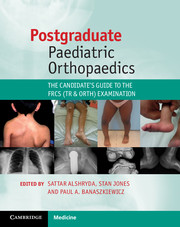Book contents
- Frontmatter
- Contents
- List of contributors
- Foreword
- Preface
- Acknowledgements
- Interactive website
- List of abbreviations
- Section 1 General guidance
- Section 2 Core structured topics
- Chapter 3 The hip
- Chapter 4 The knee
- Chapter 5 The foot and ankle
- Chapter 6 The spine
- Chapter 7 The shoulder
- Chapter 8 The elbow
- Chapter 9 Congenital hand deformities
- Chapter 10 Neuromuscular diseases
- Chapter 11 Musculoskeletal infections
- Chapter 12 Musculoskeletal tumours
- Chapter 13 Skeletal dysplasia
- Chapter 14 Metabolic bone disease
- Chapter 15 Physis and leg length discrepancy
- Chapter 16 Deformity corrections
- Chapter 17 Miscellaneous paediatric conditions
- Section 3 Exam-related material
- Index
- References
Chapter 7 - The shoulder
Published online by Cambridge University Press: 05 August 2014
- Frontmatter
- Contents
- List of contributors
- Foreword
- Preface
- Acknowledgements
- Interactive website
- List of abbreviations
- Section 1 General guidance
- Section 2 Core structured topics
- Chapter 3 The hip
- Chapter 4 The knee
- Chapter 5 The foot and ankle
- Chapter 6 The spine
- Chapter 7 The shoulder
- Chapter 8 The elbow
- Chapter 9 Congenital hand deformities
- Chapter 10 Neuromuscular diseases
- Chapter 11 Musculoskeletal infections
- Chapter 12 Musculoskeletal tumours
- Chapter 13 Skeletal dysplasia
- Chapter 14 Metabolic bone disease
- Chapter 15 Physis and leg length discrepancy
- Chapter 16 Deformity corrections
- Chapter 17 Miscellaneous paediatric conditions
- Section 3 Exam-related material
- Index
- References
Summary
Aetiology
The incidence of obstetric brachial plexus birth injury (OBPI) is around 1 per 1000 live births. Around 25% of patients are left with permanent disability without intervention. The shoulder is the most commonly affected joint and, owing to the subsequent imbalance of musculature, the abnormal deforming forces cause dysplasia of the glenohumeral joint. In the growing child, this presents with a changing pattern of pathology, which requires a multidisciplinary approach and a broad range of treatment modalities to optimize function.
A common cause is a traction injury to the brachial plexus during the later stages of vaginal delivery when the head is pulled away from the shoulder. The mechanism of injury is a forced lateral flexion of the cervical spine, resulting in injury initially to the upper cervical roots (C5–C7), causing an Erb’s palsy, and, in more severe cases, the entire brachial plexus (C5–T1). With this mechanism, isolated lower root injuries (C8–T1, Klumpke’s palsy) do not tend to occur in OBPI. Other rare causes are abnormal forces on the shoulder over the sacral promontory or abnormal forces in an abnormal uterus, such as a bicornuate or fibroid uterus.
- Type
- Chapter
- Information
- Postgraduate Paediatric OrthopaedicsThe Candidate's Guide to the FRCS (Tr and Orth) Examination, pp. 124 - 132Publisher: Cambridge University PressPrint publication year: 2014



